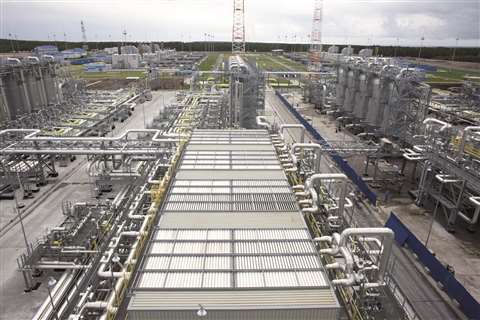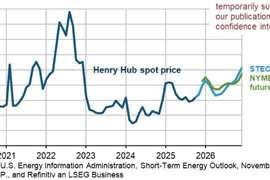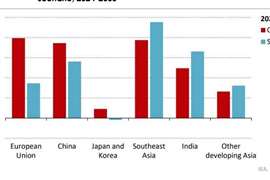Euro gas report: Gazprom cuts Nord Stream supplies
July 04, 2022
 Germany’s Siemens Energy is repairing gas compressors at the Portovaya station outside Russia. (Photo: Nord Stream.)
Germany’s Siemens Energy is repairing gas compressors at the Portovaya station outside Russia. (Photo: Nord Stream.)
Russia’s Gazprom said it was curbing supplies being delivered to Germany via the Nord Stream pipeline. The company attributed this to equipment shortages at the Portovaya compressor station in Russia, which serves as the entry point for Nord Stream.
Germany’s Siemens Energy has been repairing gas compressor units (GCUs) from the Portovaya station outside of Russia. However, Siemens confirmed that sanctions meant it was currently unable to return an aeroderivative gas turbine being overhauled in Canada. The company said it was working on a solution to the issue.
At the same time, Gazprom cited other factors including the expiration of time between overhauls of the GCUs and malfunctions detected in engines. As a result, the company said only three of the eight GCUs installed at the Portovaya compressor station could be used, cutting supplies being fed into Nord Stream from 5.9 Bcf/d (1.67 × 108 m3/d) to 3.5 Bcf/d (1 × 108 m3/d).
A day later, Gazprom announced that it was taking another Siemens turbine offline at Portovaya, citing the expiration of the prescribed time before the next overhaul and the technical condition of the unit in question. As a result, supplies through Nord Stream were further reduced to 2.4 Bcf/d (6.7 × 107 m3/d), or 40% of the pipeline’s total capacity. Shipments are reported to have been reduced to major buyers including Germany, France and Italy.
This further limits Russian gas supplies to Europe at a time when Gazprom has already suspended shipments to Europe along various routes, and has cut supplies to certain countries amid disputes over how to pay for the gas.
The European Union is moving to reduce its reliance on Russian gas as quickly as possible, but these supply reductions have nonetheless increased concerns over upcoming gas shortages when the winter arrives. The European Union has recently taken aggressive steps to transition its energy sector away from hydrocarbons (see feature on page XX), but those investments are not expected to come online soon enough to replace the immediate decline in gas shipments from Russia.
In response, the German Federal Ministry of Economics and Climate Protection entered the second stage of its emergency gas plan, a so-called alert stage. The ministry said that although current gas supplies are 58% ahead of their levels than last year, the decline in gas imports from Russia has caused serious concerns about the level of supplies as the region enters winter.
“Even if gas quantities can be procured on the market and stored, the situation is serious,” said Robert Habeck, the German minister for economic affairs and climate change. “Even if you don’t feel it yet, we are in a gas crisis.”
The German government has called additional coal-fired plants out of standby to reduce gas consumption in the power sector.
In addition to Germany, Austria, Italy and the Netherlands announced plans to revive old coal plants in an effort to replace some of the reduced gas from Russia. The move has its critics, who say a transition back to coal will likely undermine the region’s efforts to reduce emissions and fight climate change.
“We are bringing coal-fired power plants onto the market and reducing the amount of gas. That’s painful, coal-fired power plants are simply poison for the climate, but we have to do it for a transitional period to save gas and get through the winter,” Habeck said.
Meanwhile, Germany’s federal government has established a credit line of 15 billion Euros for gas companies to boost storage prior to the coming winter. It also plans to launch a gas auction model to give industrial gas consumers an incentive to save gas.
Gas fueled around 15% of Germany’s electricity generation in 2021, but the rise in gas prices has probably lowered that number in the first few months of 2022, Germany’s government said.
FINLAND
Russia cuts off gas supplies to Finland
Russia’s Gazprom halted natural gas exports to Finland in an escalation of a dispute with a number of European countries over payments for energy supplies. This came after Finland rejected Russian demands to pay for gas in rubles, and around the same time as the country applied to join the North Atlantic Treaty Organization (NATO) military alliance – another move opposed by Moscow.
Finnish gas transmission operator Gasgrid Finland said that gas flows through the Imatra entry point had stopped, with the country now relying on the Balticconnector link to Estonia for supplies.
In a separate announcement on June 9, Gasgrid Finland said it had signed a letter of intent (LoI) with Fortum on placing a floating LNG import facility at Fortum’s Inkoo port. Gasgrid Finland is leasing the Exemplar FSRU for 10 years, and aims to have the terminal ready to enter service in 2023.
The company said the Exemplar’s capacity is sufficient for the gas needs of both Finland and Estonia. This comes after both countries previously agreed to jointly charter an FSRU. Estonia is also building LNG import facilities (see story below) with the two countries aiming to mitigate against potential project risks and increase the chances of having at least one terminal site ready for next winter.
“The vessel project is absolutely essential for the security of supply of natural gas in the Baltic region – and therefore extremely urgent,” stated Gasgrid Finland’s CEO, Olli Sipilä.
The FSRU Exemplar is 291 meters long and 43 meters wide. It has a volume of approximately 151,000 cubic meters, corresponding to approximately 68,000 tonnes of LNG when fully loaded. This is roughly the equivalent of 1,050 GWh of energy content, Gasgrid announced.
The Exemplar’s evaporation capacity is 140 GWh/day, which would exceed Finland’s annual gas demand, which has historically been around 25 TWh per year. The additional capacity will enable the Exemplar to serve the gas market in the Baltic Sea region through the Balticconnector interconnector pipeline, Gasgrid announced.
The decline in gas supplies from Russia has sparked a regional crisis that could force some European countries to ration gas, said Fatih Birol, the director of the International Energy Agency told Reuters.
Europe
Howden to supply hydrogen compressors to European Energy
The UK’s Howden Energy said that it had agreed to supply hydrogen compressors to Denmark-based European Energy, which in turn has been selected by Maersk to supply e-methanol for use as a maritime fuel.
European Energy is set to deliver 200,000-300,000 tons/year of e-methanol to Maersk by 2025. The company is building the world’s first large-scale commercial e-methanol production facility that will use green hydrogen as feedstock. The green hydrogen will be provided by a 50-MW electrolyzer and compressed by Howden.
In its announcement, Howden said it would supply five compressor packages, in order to provide the required hydrogen purity, pressure and flow capacity levels on demand. The design uses non-lubricated piston compressor technology to deliver 1,370 kg/hr of green hydrogen. According to the company, the turnkey packages require minimal onsite installation and the compressors are easy to maintain throughout their lifecycle.
The project comes the shipping industry transitions to cleaner fuels. A growing number of companies is looking at the potential of green hydrogen and its derivatives to lower carbon dioxide (CO2) emissions.
BULGARIA, GREECE
IGB pipeline to enter service in July
The Interconnector Greece-Bulgaria (IGB) pipeline is due to start up on July 1 after regulators in both countries expedited the certification of the operator in response to the war in Ukraine and the resulting gas supply disruptions across Europe.
The IGB pipeline will have an initial capacity of 105.9 Bcf/y (3 × 109 m3/y), and there is potential to upgrade this to 176.6 Bcf/y (5 × 109 m3/y) by installing an additional compressor station along its route. The IGB connects to the Trans Adriatic Pipeline (TAP), as well as the Greek gas transmission system.
Bulgarian media reported in late June that the first shipment of gas from Azerbaijan on the pipeline was due to be completed by the end of the month.
Start-up of the pipeline is timely, as it comes after Russia’s Gazprom cut off gas supplies to Bulgaria in late April. This took place because the Bulgarian government rejected Russian demands to change contracts and pay for gas in rubles. In the wake of the suspension of Russian supplies, the Bulgarian energy regulator commented in late May that the IGB would be key to the security of gas supply and to more favorable pricing for customers.
ESTONIA
Work begins on pipeline connection to planned LNG terminal
Construction has started on a gas pipeline in Estonia that will eventually connect to the planned Paldiski LNG import terminal.
Estonia’s gas transmission operator, Elering, said on June 8 that the route had been marked and that the current focus was on preparatory work for the installation of the overland pipeline. Connecto is the main contractor for the work, which began at Elering’s Paldiski compressor station.
“We managed to shift the commencement of the biggest work stage of the overland part – the initiation of directional drilling work from the compressor to the coast – earlier than previously expected, with work already beginning in July,” stated Elerging’s chairman of the management board, Taavi Veskimägi.
According to the announcement, work on the project is divided into four stages – the overland pipeline from the compressor station to the coast; the submarine pipeline from the coast to the mooring quay; gas installations on the mooring quay; and connecting equipment between the quay and the floating LNG terminal.
Elering noted that the initial work would be onshore, but that “the initiation of substantive activities” for the completion of the other stages could begin in the near future as well.
The length of the connection from the compressor station to the mooring quay is around 1.2 km (0.75 miles). The link allows the LNG project to connect to the Balticconnector pipeline, which makes landfall at Paldiski.
Elering’s announcement came just over a week after Alexela Group said it had completed dredging work at the Paldiski LNG site. Construction of the mooring point is the next step for the project, and is due to be completed by September 1.
The LNG project is being developed in two stages as the entire region works to reduce its dependence on Russian gas, in co-operation with neighbouring Finland. (See previous story) The first stage entails the rental of a floating storage and regasification unit (FSRU) and the second involves development of a permanent onshore LNG terminal.
MAGAZINE
NEWSLETTER

CONNECT WITH THE TEAM








